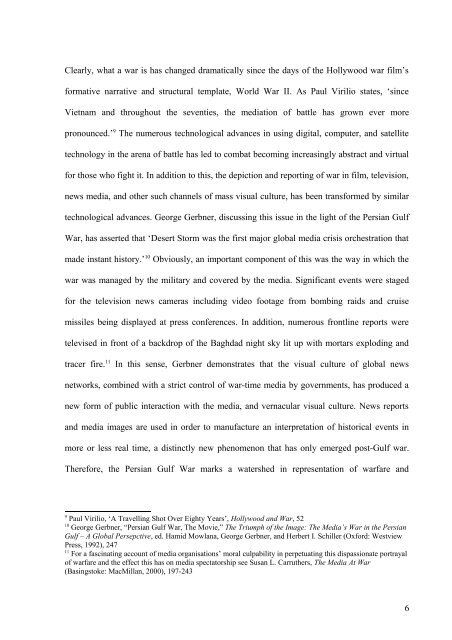the damaged male and the contemporary american war film
the damaged male and the contemporary american war film
the damaged male and the contemporary american war film
Create successful ePaper yourself
Turn your PDF publications into a flip-book with our unique Google optimized e-Paper software.
Clearly, what a <strong>war</strong> is has changed dramatically since <strong>the</strong> days of <strong>the</strong> Hollywood <strong>war</strong> <strong>film</strong>’s<br />
formative narrative <strong>and</strong> structural template, World War II. As Paul Virilio states, ‘since<br />
Vietnam <strong>and</strong> throughout <strong>the</strong> seventies, <strong>the</strong> mediation of battle has grown ever more<br />
pronounced.’ 9 The numerous technological advances in using digital, computer, <strong>and</strong> satellite<br />
technology in <strong>the</strong> arena of battle has led to combat becoming increasingly abstract <strong>and</strong> virtual<br />
for those who fight it. In addition to this, <strong>the</strong> depiction <strong>and</strong> reporting of <strong>war</strong> in <strong>film</strong>, television,<br />
news media, <strong>and</strong> o<strong>the</strong>r such channels of mass visual culture, has been transformed by similar<br />
technological advances. George Gerbner, discussing this issue in <strong>the</strong> light of <strong>the</strong> Persian Gulf<br />
War, has asserted that ‘Desert Storm was <strong>the</strong> first major global media crisis orchestration that<br />
made instant history.’ 10 Obviously, an important component of this was <strong>the</strong> way in which <strong>the</strong><br />
<strong>war</strong> was managed by <strong>the</strong> military <strong>and</strong> covered by <strong>the</strong> media. Significant events were staged<br />
for <strong>the</strong> television news cameras including video footage from bombing raids <strong>and</strong> cruise<br />
missiles being displayed at press conferences. In addition, numerous frontline reports were<br />
televised in front of a backdrop of <strong>the</strong> Baghdad night sky lit up with mortars exploding <strong>and</strong><br />
tracer fire. 11 In this sense, Gerbner demonstrates that <strong>the</strong> visual culture of global news<br />
networks, combined with a strict control of <strong>war</strong>-time media by governments, has produced a<br />
new form of public interaction with <strong>the</strong> media, <strong>and</strong> vernacular visual culture. News reports<br />
<strong>and</strong> media images are used in order to manufacture an interpretation of historical events in<br />
more or less real time, a distinctly new phenomenon that has only emerged post-Gulf <strong>war</strong>.<br />
Therefore, <strong>the</strong> Persian Gulf War marks a watershed in representation of <strong>war</strong>fare <strong>and</strong><br />
9 Paul Virilio, ‘A Travelling Shot Over Eighty Years’, Hollywood <strong>and</strong> War, 52<br />
10 George Gerbner, “Persian Gulf War, The Movie,” The Triumph of <strong>the</strong> Image: The Media’s War in <strong>the</strong> Persian<br />
Gulf – A Global Persepctive, ed. Hamid Mowlana, George Gerbner, <strong>and</strong> Herbert I. Schiller (Oxford: Westview<br />
Press, 1992), 247<br />
11 For a fascinating account of media organisations’ moral culpability in perpetuating this dispassionate portrayal<br />
of <strong>war</strong>fare <strong>and</strong> <strong>the</strong> effect this has on media spectatorship see Susan L. Carru<strong>the</strong>rs, The Media At War<br />
(Basingstoke: MacMillan, 2000), 197-243<br />
6

















